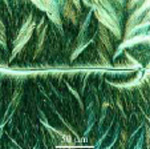|
|
Vol.
28 No. 2
March-April 2006
Microstructure
and Properties of Thermotropic Liquid-Crystalline Polymer
Blends and Composites
Liquid-crystalline
polymers (LCPs), comprised of rigid (or semi rigid) rod-like
molecules, are usually classified into two groups: lyotropic
LCPs and thermotropic LCPs, based on the conditions for the
formation of their liquid-crystalline state.
Lyotropic LCPs, such as poly(ρ-phenylene terephthalamide)
(PPTA) are processed to high-strength, high-modulus fibers
by the solution-spinning technique. Thermotropic LCPs (TLCPs)
are processed and molded to structural parts of different
shapes by means of conventional processing for thermoplastics,
such as extrusion and injection molding.
The synthesis and modification of TLCPs for different final
applications are hot topics for industrial and academic research.
The copolymerization of different comonomers produces copolymers
classified into different series, (e.g. Rodrun, Vectra, and
Xydar) with different liquid crystalline characteristics,
melting temperatures, and rheological behavior. These series
find their different end-use applications by injection molding,
extrusion, stretching, blowing, and spinning.
In recent years, the rapid development of information technology
products has lead to an annual consumption growth of 25% for
commercialized TLCP blends and composites. To fabricate final
products, different commercialized grades of TLCP blends and
composites are available as glass-fiber or carbonfiber-reinforced,
glass-bead, glass-flake, or silica-filled grades. The microstructure
of commercialized TLCP blends and composites is closely related
to their processing conditions. The relation between the rheological
properties and the resultant microstructure of these blends
and composites should be well established. The aim of this
project is to evaluate the microstructure–property relation
of the commercialized TLCP blends and composites by rheological
measurement, morphological observation, and evaluation of
property.
 |
Inversion
wall revealed by spontaneous band texture
in a liquid crystalline polymer; rigid copolyester of
hydroxybenzoate (HBA) and hydroxynapthoate (HNA)
(1:1); Cross-polarized light microscopy.
(Source: Dr W
Song, Department of Materials Science and Metallurgy,
University of Cambridge; www.doitpoms.ac.uk) |
Recently,
another report has been published in Pure
and Applied Chemistry 76,
2027–2049 (2004): “Rheological Properties
and Associated Structural Characteristics of Some Aromatic
Polycondensates, Including Liquid-Crystalline Polyesters and
Cellulose Derivatives,” by J.L. White, L. Dong, P. Han,
and H.M. Laun. This paper reports four different types of
liquid crystalline polyesters and one type of glass, fiberfilled
LCP, with sections as polarized light microscopy, capillary
rheometry (bagley plots and correction vs. wall-shear stress),
extrudate swell, structural studies of extrudates, and oscillatory
shear measurements (amplitude sweeps, time sweeps, frequency
sweeps, and temperature sweeps).
This project will focus on TLCP blends and composites. The
topics of study include:
1.
rheological measurements of TLCP blends and composites
2. dynamic viscoelasticity, stress relaxation, and shear/elongational
viscosities
3. morphological observation of molded samples
4. scanning electron microscopy, transmission electron microscopy,
and atomic-force microscopy observation
5. blending with other polymers
6. rheological properties of blends and microstructure observation
7. crystallization of TLCP blends and composites
8. differential scanning calorimetry measurements, scanning
electron microscopy, and polarized optical microscopy observation
9. mechanical testing of molded samples
10. static mechanical properties and dynamic mechanical
analysis
For more information
and comments, contact the task group chairman, Jiasong He
<[email protected]>.
www.iupac.org/projects/2004/2004-044-2-400.html
Page
last modified 10 August 2006.
Copyright © 2003-2006 International Union of Pure and
Applied Chemistry.
Questions regarding the website, please contact [email protected]
|